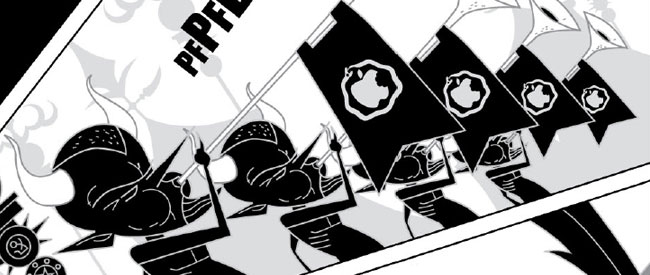
James Turner, of Rex Libris and Warlord of IO fame, has a new digital comic book coming out in August from SLG Publishing. Rebel Angels focuses on a revolution in Hell as the demons begin to question which side they’re on. James talked with us about the book in anticipation of its release.
BROKEN FRONTIER: What influenced the creation of Rebel Angels? Your website describes it as a take on Paradise Lost crossed with Monster’s University. What other works did you have in mind as you created this, and just how much did you look to Paradise Lost for inspiration?
JAMES TURNER: Paradise Lost and Dante’s Inferno were the basis for the world. I looked to them for the history of hell and the geography, but a lot was added on top. Revolutions throughout history were another major inspiration. If you look close, you’ll catch lots of references and even a few quotes.
Visually, I’ve been working long enough to self-reference. When I started Rebel Angels in 2007, it had a much flatter look, like Nil: A Land Beyond Belief. It started out as a sequel to that book, actually. I left it to work on Warlord of Io, and when I went back to it, the more cartoon/animated feel of Warlord of Io transferred to Rebel Angels.
To regress even further, Nil was influenced by my love of architectural drawings and blueprints, while Warlord of Io drew from Frank R. Paul, the unsurpassed herald of the Retro-Future.
On top of that, I slathered influences like Piranesi’s Prison etchings, Bosch, Bruegel, and Louis Le Breton. Several demon designs are directly based on creations of Bosch and Breton. I wanted to establish an infernal visual verisimilitude that way, even if only on a subconscious level. It’s fun to spot them, too. And of course there’s a little John Martin in there. He’s the Roland Emmerich of 19th century painting.
The premise of the series sounds like it’s ripe for both serious and comedic moments. How do you balance that humor to give your series stakes, while simultaneously keeping that fun tone that is such a breath of fresh air in today’s market?
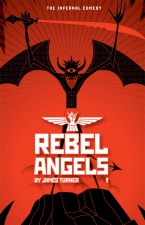 Many of the things we take seriously are inherently absurd. Mutual Assured Destruction (MAD) for example. The trench attacks of World War I. Yet the stakes are incredibly high. I believe humor can help keep you sane in the face of madness. For example, it wouldn’t surprise me if soldiers in the trenches developed a very dark sense of humor. How else could you deal with it?
Many of the things we take seriously are inherently absurd. Mutual Assured Destruction (MAD) for example. The trench attacks of World War I. Yet the stakes are incredibly high. I believe humor can help keep you sane in the face of madness. For example, it wouldn’t surprise me if soldiers in the trenches developed a very dark sense of humor. How else could you deal with it?
If people care about the characters and you take existential threats seriously (no matter how crazy those threats are) you avoid undermining the drama to a large degree. Striking the right balance can be a problem, of course, and I can only hope I do so here. Howard Overman’s Misfits, a British TV show, did that wonderfully during the first three seasons. The characters were compelling, the humour raunchy, and the action kick-ass. TV’s Buffy the Vampire Slayer and films like The Incredibles, An American Werewolf in London, Ghostbusters, Tremors, Zombieland, The Cabin in the Woods, and ParaNorman all do this brilliantly. Cabin in the Woods in particular played with the absurdity of the whole genre’s premise in what I can only describe as an orgy of brilliance. That’s the sort of thing I looked to when striving for balance. Aim high!
Speaking of the books humor, it seems that much of it comes from actions or signs in the background. Do you design your pages with those “Easter eggs” in mind to heighten the experience for the thorough reader?
I try to; Nil: A Land Beyond Belief went much further with this, to the point of slowing down the narrative with multitudinous background billboards. Here I tried to squeeze them in without it becoming distracting. I hope to ramp it up in the next volume as competing factions advertise. That will be loads of fun.
What role, if any, does humanity play in this struggle between demons and angels?
Initially, not much. I wanted the focus to be on the Fallen Angels. People are background noise. Concerns of the day job. As the series progresses and the scope of the conflict expands, humanity plays a greater role.
We see a bit of Balthazar’s parents and sister, along with a mention of his ex-wife, in this first installment. How important is family in Hell? When sinning is the order of the day, how much room is there for familial bonds?
That’s an excellent question. Milton has Satan declare ‘Evil be Thou My Good’. Yet without any positive bonds or characteristics, everything would collapse. You can’t build or organize without circles of trust. Nothing constructive would get done. So in writing up a Brief History of Hell (the background document for the book), I decided that revolutionary ideologues would indeed implement a policy that completely rejects all that is good, including love, loyalty, and family. But, they would eventually be forced to abandon it as inherently unworkable. It goes back to moderation, which is a theme that’s explored in many of my books.
From the History of Hell:
“The Magisterium rashly adopted the Animus Creed, which affirmed evil as Hell’s good (‘Evil be Thou My Good’). This made cooperation impossible: it became screw or be screwed and all order collapsed. Servants stopped serving. Guards made off with the silverware. Parents ate their kids. Thinking better of it, the decree was rescinded and the more restrained Pandemonium Creed, advocating opposition to God ‘The Fascist Father’, was adopted in its place.”
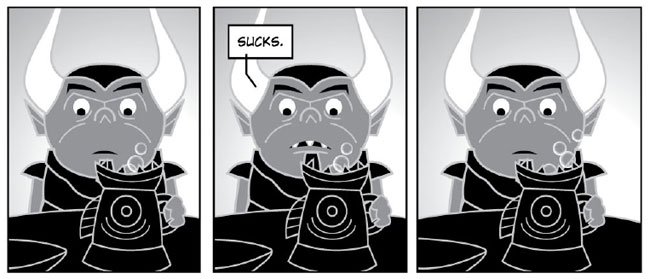
How do you go about creating a series that’s primarily focused on the demon debate over Heaven vs. Hell without making Heaven the clear right answer and Hell the clear wrong answer?
Hmm. This question could get one in a lot of trouble. In part it depends on what you’re really talking about, beneath the surface narrative. If you look at Heaven as order (calcification) and Hell as disorder (chaos), both have flaws. It can be a question of going too far. There are also elements of the debate that won’t be seen until much later in the series that cast the struggle in a different light. Whatever the case, Heaven won’t take them back, even if Heaven is the right answer. So they’re left to pursue the options available.
What went into the character design choices? The premise mentions Monster’s University and I can’t help but see a touch of Pixar in your art. Why go this style as opposed to a more typical “scary” style of Hell?
Because the scary style, while impressive, is so ubiquitous these days. I deliberately avoided looking at any contemporary visions of Hell while creating the book. Last week, I looked at a World of Warcraft art book which includes a section that, while set on earth, resembles Hell. It’s wonderful: fantastic creatures, buildings, the works. All have a superb, big budget movie feel. But that’s everything these days: awesome but the same flavor.
I wanted to be travel outside that envelope, to harken back to Bosch and Bruegel and Louis Le Breton (who is wonderful but comparatively unknown). Rest assured there are demons with horns, hooves, and bat wings; I couldn’t exclude them entirely. But the gamut of creatures is, I hope, refreshingly broad.
I blame Warlord of Io for any Pixar-like influence.
How long do you envision this series going? Is there a specific storyline you have in mind, or is there room for diversions or the Rebel Angels equivalent of the X-Men baseball stories, where we take a break from the war to see these demons on their downtime?
That’s an interesting idea. I do have a specific storyline and ending in mind, but I’d love to spend time exploring character and smelling the roses if the audience is there for it. There’s so much you can do with the setting. I’ve just scratched the surface.
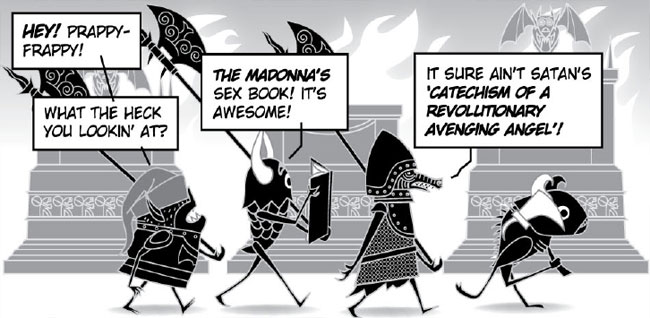
The blacks, whites, and grays are so strong that this book feels colored in a way. What was the decision to make the series black and white, when Hell is often associated with a fire-red color?
I wanted to see it printed, at least eventually, and printing in black and white can be substantially cheaper. I hope to do some color shorts after this project, but they’d have to be more limited in scope for cost and pricing reasons.
Seeing as how this series is intended to be digital first, what went into the decision to do the book in a portrait format versus a landscape one, which many people are finding to be ideal for the digital medium? You’ve used the portrait format to really illustrate height in the building design, does this have something to do with the format decision?
Have to admit I never considered the landscape format. Print format just too ingrained. Went with it without thinking. Total autopilot. D’oh!
Check out Comixology or SLG Publishing in August to download your copy of Rebel Angels.





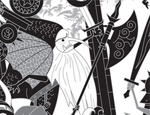
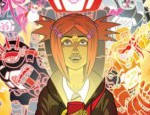
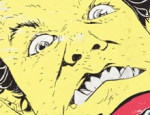
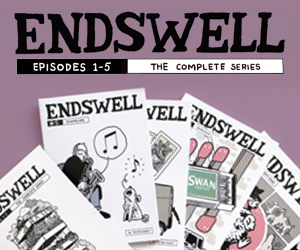

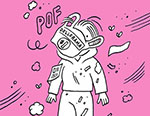
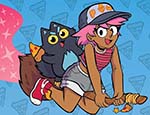
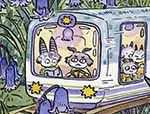
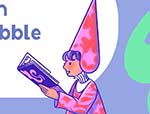
cool
[…] https://www.brokenfrontier.com/ruling-in-hell-a-conversation-with-james-turner-on-rebel-angels/ […]